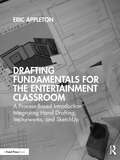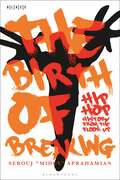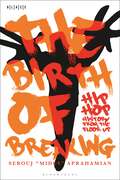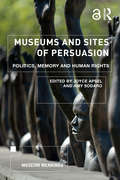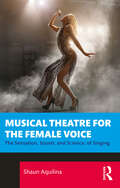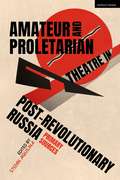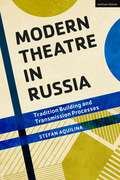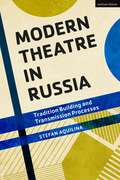- Table View
- List View
Integrated Sustainable Design of Buildings
by Paul ApplebyIntegrated Sustainable Design of Buildings aims to provide a guide to members of design and masterplanning teams on how to deliver sustainable development and buildings cost effectively, meeting current and emerging UK and international statutory and planning requirements. Using a series of case histories and examples from the author's ten years of providing sustainability advisory services the book sets out a clear and understandable strategy that deals with all aspects of sustainable design and construction and the implications for delivery, costs, saleability and long term operation. The extensive scope includes all aspects of environmental, social and economic sustainability, including strategies to reduce carbon emissions and the impact of climate change. Integrated Sustainable Design of Buildings appeared in the Cambridge Top 40 Sustainability Books of 2010.
Sustainable Retrofit and Facilities Management
by Paul ApplebyGovernments across the globe are setting targets for reducing their carbon emissions. For example, the UK Government has committed to an eighty per cent reduction by 2050, when twenty-eight million buildings that currently exist will still be standing; this represents a challenge to improve the energy efficiency of more than one building per minute between now and 2050! This is a problem that needs tackling worldwide and is a challenge to both the refurbishment sector of the global construction industry and to those who own and operate existing buildings. Sustainable Retrofit and Facilities Management provides comprehensive guidance to those involved in the refurbishment and management of existing buildings on minimizing carbon emissions, water consumption and waste to landfill, along with enhancing the long term sustainability of a building. Practical guidance is provided on measures that can be used to improve the efficiency and sustainability of existing buildings, through both good management and refurbishment. Also explored is the relationship between the refurbishment of existing buildings, facility management and the wider community infrastructure. The book looks at management tools such as post occupancy evaluation, building health checks, energy management software, green building management toolkits and green leases. Illustrated throughout with case studies and examples of best practice, this is a must-have handbook for engineers, architects, developers, contractors and facility managers.
Sustainable Retrofit and Facilities Management
by Paul ApplebyGovernments across the globe are setting targets for reducing their carbon emissions. For example, the UK Government has committed to an eighty per cent reduction by 2050, when twenty-eight million buildings that currently exist will still be standing; this represents a challenge to improve the energy efficiency of more than one building per minute between now and 2050! This is a problem that needs tackling worldwide and is a challenge to both the refurbishment sector of the global construction industry and to those who own and operate existing buildings. Sustainable Retrofit and Facilities Management provides comprehensive guidance to those involved in the refurbishment and management of existing buildings on minimizing carbon emissions, water consumption and waste to landfill, along with enhancing the long term sustainability of a building. Practical guidance is provided on measures that can be used to improve the efficiency and sustainability of existing buildings, through both good management and refurbishment. Also explored is the relationship between the refurbishment of existing buildings, facility management and the wider community infrastructure. The book looks at management tools such as post occupancy evaluation, building health checks, energy management software, green building management toolkits and green leases. Illustrated throughout with case studies and examples of best practice, this is a must-have handbook for engineers, architects, developers, contractors and facility managers.
Drafting Fundamentals for the Entertainment Classroom: A Process-Based Introduction Integrating Hand Drafting, Vectorworks, and SketchUp
by Eric AppletonDrafting Fundamentals for the Entertainment Classroom: A Process-Based Introduction to Hand Drafting, Vectorworks, and SketchUp guides students through a syllabus-formatted semester of integrated drafting concepts and skills. This book links beginner visualization practices with fundamental software knowledge through step-by-step exercises and examples. By presenting hand drafting and Vectorworks through incremental exercises, students not only gain an understanding of the tools used in drafting but also learn why the tools, practices, and standards exist in the first place. SketchUp, a user-friendly 3D modeling program, is integrated into the various exercises to help readers visualize concepts and begin modeling their own ideas. By the end of the book, students will understand drawing construction techniques, United States Institute for Theatre Technology (USITT)-recommended graphic standards, and the typical drawings created for entertainment design, preparing them to dive more deeply into the further complexities and opportunities of Vectorworks and SketchUp. Drafting Fundamentals for the Entertainment Classroom is written to complement a 14- or 15-week semester of an Entertainment Drafting course. The book’s format also provides structure for independent and self-directed study.
Drafting Fundamentals for the Entertainment Classroom: A Process-Based Introduction Integrating Hand Drafting, Vectorworks, and SketchUp
by Eric AppletonDrafting Fundamentals for the Entertainment Classroom: A Process-Based Introduction to Hand Drafting, Vectorworks, and SketchUp guides students through a syllabus-formatted semester of integrated drafting concepts and skills. This book links beginner visualization practices with fundamental software knowledge through step-by-step exercises and examples. By presenting hand drafting and Vectorworks through incremental exercises, students not only gain an understanding of the tools used in drafting but also learn why the tools, practices, and standards exist in the first place. SketchUp, a user-friendly 3D modeling program, is integrated into the various exercises to help readers visualize concepts and begin modeling their own ideas. By the end of the book, students will understand drawing construction techniques, United States Institute for Theatre Technology (USITT)-recommended graphic standards, and the typical drawings created for entertainment design, preparing them to dive more deeply into the further complexities and opportunities of Vectorworks and SketchUp. Drafting Fundamentals for the Entertainment Classroom is written to complement a 14- or 15-week semester of an Entertainment Drafting course. The book’s format also provides structure for independent and self-directed study.
Teaching Introduction to Theatrical Design: A Process Based Syllabus in Costumes, Scenery, and Lighting
by Eric Appleton Tracey LyonsTeaching Introduction to Theatrical Design is a week-by-week guide that helps instructors who are new to teaching design, teaching outside of their fields of expertise, or looking for better ways to integrate and encourage non-designers in the design classroom. This book provides a syllabus to teach foundational theatrical design by illustrating process and application of the principals of design in costumes, sets, lights, and sound.
Teaching Introduction to Theatrical Design: A Process Based Syllabus in Costumes, Scenery, and Lighting
by Eric Appleton Tracey LyonsTeaching Introduction to Theatrical Design is a week-by-week guide that helps instructors who are new to teaching design, teaching outside of their fields of expertise, or looking for better ways to integrate and encourage non-designers in the design classroom. This book provides a syllabus to teach foundational theatrical design by illustrating process and application of the principals of design in costumes, sets, lights, and sound.
Art and Mysticism: Interfaces in the Medieval and Modern Periods (Contemporary Theological Explorations in Mysticism)
by Helen Appleton Louise NelstropFrom the visual and textual art of Anglo-Saxon England onwards, images held a surprising power in the Western Christian tradition. Not only did these artistic representations provide images through which to find God, they also held mystical potential, and likewise mystical writing, from the early medieval period onwards, is also filled with images of God that likewise refracts and reflects His glory. This collection of essays introduces the currents of thought and practice that underpin this artistic engagement with Western Christian mysticism, and explores the continued link between art and theology. The book features contributions from an international panel of leading academics, and is divided into four sections. The first section offers theoretical and philosophical considerations of mystical aesthetics and the interplay between mysticism and art. The final three sections investigate this interplay between the arts and mysticism from three key vantage points. The purpose of the volume is to explore this rarely considered yet crucial interface between art and mysticism. It is therefore an important and illuminating collection of scholarship that will appeal to scholars of theology and Christian mysticism as much as those who study literature, the arts and art history.
Buildings for the Performing Arts
by Ian AppletonThis Design and Development Guide is an essential book for those who are involved in the initiation, planning, design and building of facilities for the various performing arts, from local to metropolitan locations. It includes the stages in the development, decisions to be taken, information requirements, feasibility and advice necessary in the design and development of a new or adapted building. Part one of this guide provides the background information about the organisation of the performing arts, the prevailing issues, the client and various building types. In the second part, the author deals with the components of design and development, identifying the roles of the client, advisors and consultants, the stages to be achieved, including client’s proposal feasibility, the process of briefing, design and building and eventually hand-over and opening night, with a consideration of the building use. Studies include the assessment of demand, site requirements, initial brief, building design and financial viability. Information requirements, as design standards, for the auditorium and platform/stage, and the support facilities, are included. Separate studies focus on the adaptation of existing buildings and provision for children and young persons. THE CONTENT COVERS A WIDE RANGE OF PERFORMING ARTS (CLASSICAL MUSIC, POP/ROCK, JAZZ, MUSICALS, DANCE, DRAMA) AND PROVIDES INFORMATION ON EACH AS AN ART FROM AND NECESSITIES TO HOUSE PERFORMANCES.
Buildings for the Performing Arts
by Ian AppletonThis Design and Development Guide is an essential book for those who are involved in the initiation, planning, design and building of facilities for the various performing arts, from local to metropolitan locations. It includes the stages in the development, decisions to be taken, information requirements, feasibility and advice necessary in the design and development of a new or adapted building. Part one of this guide provides the background information about the organisation of the performing arts, the prevailing issues, the client and various building types. In the second part, the author deals with the components of design and development, identifying the roles of the client, advisors and consultants, the stages to be achieved, including client’s proposal feasibility, the process of briefing, design and building and eventually hand-over and opening night, with a consideration of the building use. Studies include the assessment of demand, site requirements, initial brief, building design and financial viability. Information requirements, as design standards, for the auditorium and platform/stage, and the support facilities, are included. Separate studies focus on the adaptation of existing buildings and provision for children and young persons. THE CONTENT COVERS A WIDE RANGE OF PERFORMING ARTS (CLASSICAL MUSIC, POP/ROCK, JAZZ, MUSICALS, DANCE, DRAMA) AND PROVIDES INFORMATION ON EACH AS AN ART FROM AND NECESSITIES TO HOUSE PERFORMANCES.
The Musical Theatre Composer as Dramatist: A Handbook for Collaboration
by Rebecca Applin WarnerDramaturgy is at the heart of any musical theatre score, proving that song and music combined can collectively act as drama. The Musical Theatre Composer as Dramatist: A Handbook for Collaboration offers techniques for approaching a musical with the drama at the centre of the music. Written by a working composer of British musical theatre, this original and highly practical book is intended for composers, students of musical theatre and performing arts and their collaborators. Through detailed case studies, conceptual frameworks and frank analysis, this book encourages the collaboration between the languages of music and drama. It offers a shared language for talking about music in the creation of musical theatre, as well as practical exercises for both composers and their collaborators and ways of analysing existing musical theatre scores for those who are versed in musical terminology, and those who are not.Speaking directly to the contemporary artist, working examples are drawn from a wide range of musicals throughout Part One, before a full case study analysis of Matilda the Musical brings all the ideas together in Part Two. Part Three offers a range of practical exercises for anyone creating new musicals, particularly composers and their collaborators.
The Musical Theatre Composer as Dramatist: A Handbook for Collaboration
by Rebecca Applin WarnerDramaturgy is at the heart of any musical theatre score, proving that song and music combined can collectively act as drama. The Musical Theatre Composer as Dramatist: A Handbook for Collaboration offers techniques for approaching a musical with the drama at the centre of the music. Written by a working composer of British musical theatre, this original and highly practical book is intended for composers, students of musical theatre and performing arts and their collaborators. Through detailed case studies, conceptual frameworks and frank analysis, this book encourages the collaboration between the languages of music and drama. It offers a shared language for talking about music in the creation of musical theatre, as well as practical exercises for both composers and their collaborators and ways of analysing existing musical theatre scores for those who are versed in musical terminology, and those who are not.Speaking directly to the contemporary artist, working examples are drawn from a wide range of musicals throughout Part One, before a full case study analysis of Matilda the Musical brings all the ideas together in Part Two. Part Three offers a range of practical exercises for anyone creating new musicals, particularly composers and their collaborators.
The Birth of Breaking: Hip-Hop History from the Floor Up (Black Literary and Cultural Expressions)
by Serouj "Midus" AprahamianThe untold story of how breaking – one of the most widely practiced dance forms in the world today – began as a distinctly African American expression in the Bronx, New York, during the 1970s. Breaking is the first and most widely practiced hip-hop dance in the world, with around one million participants in this dynamic, multifaceted artform – and, as of 2024, Olympic sport. Yet, despite its global reach and nearly 50-year history, stories of breaking's origins have largely neglected the African Americans who founded it. Dancer and scholar Serouj "Midus" Aprahamian offers, for the first time, a detailed look into the African American beginnings of breaking in the Bronx, New York. The Birth of Breaking challenges numerous myths and misconceptions that have permeated studies of hip-hop's evolution, considering the influence breaking has had on hip-hop culture. Including previously unseen archival material, interviews, and detailed depictions of the dance at its outset, this book brings to life this buried history, with a particular focus on the early development of the dance, the institutional settings where hip-hop was conceived, and the movement's impact on sociocultural conditions in New York City throughout the 1970s. By featuring the overlooked first-hand accounts of over 50 founding b-boys and b-girls alongside movement analysis informed by his embodied knowledge of the dance, Aprahamian reveals how indebted breaking is to African American culture, as well as the disturbing factors behind its historical erasure.
The Birth of Breaking: Hip-Hop History from the Floor Up (Black Literary and Cultural Expressions)
by Serouj "Midus" AprahamianThe untold story of how breaking – one of the most widely practiced dance forms in the world today – began as a distinctly African American expression in the Bronx, New York, during the 1970s. Breaking is the first and most widely practiced hip-hop dance in the world, with around one million participants in this dynamic, multifaceted artform – and, as of 2024, Olympic sport. Yet, despite its global reach and nearly 50-year history, stories of breaking's origins have largely neglected the African Americans who founded it. Dancer and scholar Serouj "Midus" Aprahamian offers, for the first time, a detailed look into the African American beginnings of breaking in the Bronx, New York. The Birth of Breaking challenges numerous myths and misconceptions that have permeated studies of hip-hop's evolution, considering the influence breaking has had on hip-hop culture. Including previously unseen archival material, interviews, and detailed depictions of the dance at its outset, this book brings to life this buried history, with a particular focus on the early development of the dance, the institutional settings where hip-hop was conceived, and the movement's impact on sociocultural conditions in New York City throughout the 1970s. By featuring the overlooked first-hand accounts of over 50 founding b-boys and b-girls alongside movement analysis informed by his embodied knowledge of the dance, Aprahamian reveals how indebted breaking is to African American culture, as well as the disturbing factors behind its historical erasure.
Introducing Peace Museums (Routledge Research in Museum Studies)
by Joyce ApselNominated for the 2017 Dayton Literary Peace Prize in non-fiction This volume examines peace museums, a small and important (but often overlooked) series of museums whose numbers have multiplied world-wide in recent decades. They relate stories and display artifacts—banners, diaries, and posters for example about such themes as: art and peace, antiwar histories, protest, peacekeeping and social justice and promote cultures of peace. This book introduces their different approaches from Japan, which has the largest number of sites, to Bradford, UK and Guernica, Spain. Some peace museums and centers emphasize popular peace symbols and figures, others provide alternative narratives about conscientious objection or civil disobedience, and still others are sites of persuasion, challenging the status quo about issues of war, peace, disarmament, and related issues. Introducing Peace Museums distinguishes between different types of museums that are linked to peace in name, theme or purpose and discusses the debates which surround peace museums versus museums for peace. This book is the first of its kind to critically evaluate the exhibits and activities of this group of museums, and to consider the need for a "critical peace museum studies" which analyses their varied emphasis and content. The work of an experienced specialist, this welcome introduction to peace museums considers the challenges and opportunities faced by these institutions now and in the future.
Introducing Peace Museums (Routledge Research in Museum Studies)
by Joyce ApselNominated for the 2017 Dayton Literary Peace Prize in non-fiction This volume examines peace museums, a small and important (but often overlooked) series of museums whose numbers have multiplied world-wide in recent decades. They relate stories and display artifacts—banners, diaries, and posters for example about such themes as: art and peace, antiwar histories, protest, peacekeeping and social justice and promote cultures of peace. This book introduces their different approaches from Japan, which has the largest number of sites, to Bradford, UK and Guernica, Spain. Some peace museums and centers emphasize popular peace symbols and figures, others provide alternative narratives about conscientious objection or civil disobedience, and still others are sites of persuasion, challenging the status quo about issues of war, peace, disarmament, and related issues. Introducing Peace Museums distinguishes between different types of museums that are linked to peace in name, theme or purpose and discusses the debates which surround peace museums versus museums for peace. This book is the first of its kind to critically evaluate the exhibits and activities of this group of museums, and to consider the need for a "critical peace museum studies" which analyses their varied emphasis and content. The work of an experienced specialist, this welcome introduction to peace museums considers the challenges and opportunities faced by these institutions now and in the future.
Museums for Peace: In Search of History, Memory, and Change
by Joyce Apsel Clive Barrett Roy TamashiroMuseums for Peace: In Search of History, Memory and Change highlights the inspiring as well as conflicting representations and purposes of diverse museums for peace around the world.Coming from various cultural and professional backgrounds, the authors explore “what are museums for peace and what do they mean?” Some chapters introduce alternative histories of peace, conflict, and memorialization. This innovative collection examines grassroots museums, military sexual slavery, historical memory in East Asia, and cultural heritage in the Africanized peace museum movement. The chapters discuss differing representations of Gandhi, technology of war and opposition to it, and structural violence such as racial terror and imperialism. Investigating how institutions interact with political and cultural forces, the volume demonstrates that some museums reinforce hegemonic narratives, while others resist authoritative tropes to reveal silenced histories, including peace histories.Museums for Peace will appeal to academics and students in museum studies, heritage studies, peace studies, memory studies, social justice, and human rights. Those working in cultural studies and trauma studies will also find this volume valuable.The Open Access version of this book, available at http://www.taylorfrancis.com, has been made available under a Creative Commons Attribution-Non Commercial-No Derivatives (CC-BY-NC-ND)] 4.0 license.
Museums and Sites of Persuasion: Politics, Memory and Human Rights (Museum Meanings)
by Joyce Apsel Amy SodaroMuseums and Sites of Persuasion examines the concept of museums and memory sites as locations that attempt to promote human rights, democracy and peace. Demonstrating that such sites have the potential to act as powerful spaces of persuasion or contestation, the book also shows that there are perils in the selective memory and history that they present. Examining a range of museums, memorials and exhibits in places as varied as Burundi, Denmark, Georgia, Kosovo, Mexico, Peru, Vietnam and the US, this volume demonstrates how they represent and try to come to terms with difficult histories. As sites of persuasion, the contributors to this book argue, their public goal is to use memory and education about the past to provide moral lessons to visitors that will encourage a more democratic and peaceful future. However, the case studies also demonstrate how political, economic and social realities often undermine this lofty goal, raising questions about how these sites of persuasion actually function on a daily basis. Straddling several interdisciplinary fields of research and study, Museums and Sites of Persuasion will be essential reading for those working in the fields of museum studies, memory studies, and genocide studies. It will also be essential reading for museum practitioners and anyone engaged in the study of history, sociology, political science, anthropology and art history.
Museums and Sites of Persuasion: Politics, Memory and Human Rights (Museum Meanings)
by Joyce Apsel Amy SodaroMuseums and Sites of Persuasion examines the concept of museums and memory sites as locations that attempt to promote human rights, democracy and peace. Demonstrating that such sites have the potential to act as powerful spaces of persuasion or contestation, the book also shows that there are perils in the selective memory and history that they present. Examining a range of museums, memorials and exhibits in places as varied as Burundi, Denmark, Georgia, Kosovo, Mexico, Peru, Vietnam and the US, this volume demonstrates how they represent and try to come to terms with difficult histories. As sites of persuasion, the contributors to this book argue, their public goal is to use memory and education about the past to provide moral lessons to visitors that will encourage a more democratic and peaceful future. However, the case studies also demonstrate how political, economic and social realities often undermine this lofty goal, raising questions about how these sites of persuasion actually function on a daily basis. Straddling several interdisciplinary fields of research and study, Museums and Sites of Persuasion will be essential reading for those working in the fields of museum studies, memory studies, and genocide studies. It will also be essential reading for museum practitioners and anyone engaged in the study of history, sociology, political science, anthropology and art history.
Musical Theatre for the Female Voice: The Sensation, Sound, and Science, of Singing
by Shaun AquilinaFemale musical theatre singers produce some of the most exciting and expressive singing an audience can experience. They also face a unique and specific set of issues when approaching their craft, from negotiating the registers of their voice to enable them to belt, to vocal health challenges such as premenstrual voice syndrome. This is the only book that offers a full and detailed guide to tackling those issues and to singing with full expression and technical excellence. Musical Theatre for the Female Voice covers the origin of singing in musicals, from the bel canto style of 300 years ago through to the latest developments in high belting, in shows such as Wicked and Waitress. It offers the reader exercises and methods that have been used to train hundreds of singers at some of the UK’s leading musical theatre training institutions and are underpinned by the latest academic research in journals on singing, psychology, and health. Every element of a singer's toolkit is covered from a female perspective, from breath and posture to character work and vocal health. This is an essential guidebook for female singers in musical theatre productions, either training at university or conservatory level or forging a career as professional triple-threat performers.
Musical Theatre for the Female Voice: The Sensation, Sound, and Science, of Singing
by Shaun AquilinaFemale musical theatre singers produce some of the most exciting and expressive singing an audience can experience. They also face a unique and specific set of issues when approaching their craft, from negotiating the registers of their voice to enable them to belt, to vocal health challenges such as premenstrual voice syndrome. This is the only book that offers a full and detailed guide to tackling those issues and to singing with full expression and technical excellence. Musical Theatre for the Female Voice covers the origin of singing in musicals, from the bel canto style of 300 years ago through to the latest developments in high belting, in shows such as Wicked and Waitress. It offers the reader exercises and methods that have been used to train hundreds of singers at some of the UK’s leading musical theatre training institutions and are underpinned by the latest academic research in journals on singing, psychology, and health. Every element of a singer's toolkit is covered from a female perspective, from breath and posture to character work and vocal health. This is an essential guidebook for female singers in musical theatre productions, either training at university or conservatory level or forging a career as professional triple-threat performers.
Amateur and Proletarian Theatre in Post-Revolutionary Russia: Primary Sources
by Stefan AquilinaThis is the first collection of primary sources that addresses the amateur theatre produced by the workers in the first decade after the Russian Revolution. Newly translated from the Russian, the essays capture both theoretical articulations on the scene – by luminaries such as Alexander Bogdanov, Platon Kerzhentsev, Valerian Pletnev, Alexander Mgebrov and Valentin Smyshliaev – and the more fleeting descriptions and first-hand accounts of the productions staged, accounts and voices which are typically harder to capture. The essays tell a story of unabashed optimism in the creativity of the working classes. They speak of the use of theatre to carve a public and political role in the construction of a new world. The sources, however, also exhibit the flipside of the scene, or the sombre difficulties faced by the amateur actors and the incessant calls to raise standards through professional help. The narrative developed is that of an amateur theatre which began as an autonomous and heterogeneous activity but which by the mid-to-late 1920s was transformed into a regulated practice and a space for cultural programming. The collection makes an important contribution to our understanding of modern theatre: scholarship conventionally tackles the canonical names from the professional world but gives little attention to the more down-to-earth forms of performance taking place in factories, clubs and amateur circles. An introductory essay also highlights the range and significance of the collection and draws links between the essays.
Modern Theatre in Russia: Tradition Building and Transmission Processes
by Stefan AquilinaWhat did modern theatre in Russia look like and how did it foreground tradition building and transmission processes? The book challenges conventional historiographical approaches by weaving contemporary theories on cultural transmission into its historical narrative. It argues that processes of transmission – training spaces, acting manuals, photographic evidence, newspaper reports, international networking, informal encounters, cultural memories – contribute to the formation and consolidation of theatre traditions. Through English translations of rare Russian sources, the book expounds on:*side-lined material on Stanislavsky, including his relationship with German actor Ludwig Barnay, use of improvisation at the First Studio, and rehearsal practices for Artists and Admirers (1933);*Valentin Smyshlaev's acting manual The Technique to Process Stage Performance and the creation of hybrid practices;*proletarian theatre as an amateur-professional combination and force in the transformation of everyday life, as seen in the Proletkult's volume Art at the Workers' Clubs; *Meyerhold's Borodin Studio as an early example of Practice as Research, his European tour of 1930, and international persona as depicted in newspapers published in the West; and*Asja Lacis's work with children, which contributes to current efforts to address the gender imbalance that is often characteristic of modernism.This historical-theoretical investigation is combined with practical exercises that provide a more experiential understanding of the modern performance realities involved. In this way, the book speaks not only to theatre scholars and historians, but also to students and practitioners engaged in practical work.
Modern Theatre in Russia: Tradition Building and Transmission Processes
by Stefan AquilinaWhat did modern theatre in Russia look like and how did it foreground tradition building and transmission processes? The book challenges conventional historiographical approaches by weaving contemporary theories on cultural transmission into its historical narrative. It argues that processes of transmission – training spaces, acting manuals, photographic evidence, newspaper reports, international networking, informal encounters, cultural memories – contribute to the formation and consolidation of theatre traditions. Through English translations of rare Russian sources, the book expounds on:*side-lined material on Stanislavsky, including his relationship with German actor Ludwig Barnay, use of improvisation at the First Studio, and rehearsal practices for Artists and Admirers (1933);*Valentin Smyshlaev's acting manual The Technique to Process Stage Performance and the creation of hybrid practices;*proletarian theatre as an amateur-professional combination and force in the transformation of everyday life, as seen in the Proletkult's volume Art at the Workers' Clubs; *Meyerhold's Borodin Studio as an early example of Practice as Research, his European tour of 1930, and international persona as depicted in newspapers published in the West; and*Asja Lacis's work with children, which contributes to current efforts to address the gender imbalance that is often characteristic of modernism.This historical-theoretical investigation is combined with practical exercises that provide a more experiential understanding of the modern performance realities involved. In this way, the book speaks not only to theatre scholars and historians, but also to students and practitioners engaged in practical work.
Stanislavsky and Pedagogy (Stanislavsky And...)
by Stefan AquilinaStanislavsky and Pedagogy explores current thinking around the pedagogical implications of Stanislavsky’s work. The volume depicts the voices of a number of practitioners, teachers, and scholars who are themselves journeying with Stanislavsky, and who in his work find a potent instigator for their own pedagogical practice and study. This book outlines instances in which updated interpretations of Stanislavsky’s pedagogy are adapted to cater for contemporary needs and scenarios. These include the theatre industry, new digital technologies, the need to develop playfulness, application to a broad repertoire, performance as pedagogy, university managerialism, and interdisciplinary crossovers with dance and opera. The pedagogies that emerge from these case-studies are marked by fluidity and non-fixity and help to underscore the malleability of Stanislavsky’s system. Stanislavsky And... is a series of multi-perspectival collections that bring the enduring legacy of Stanislavskian actor training into the spotlight of contemporary performance culture, making them ideal for students, teachers, and scholars of acting, actor training, and directing.


